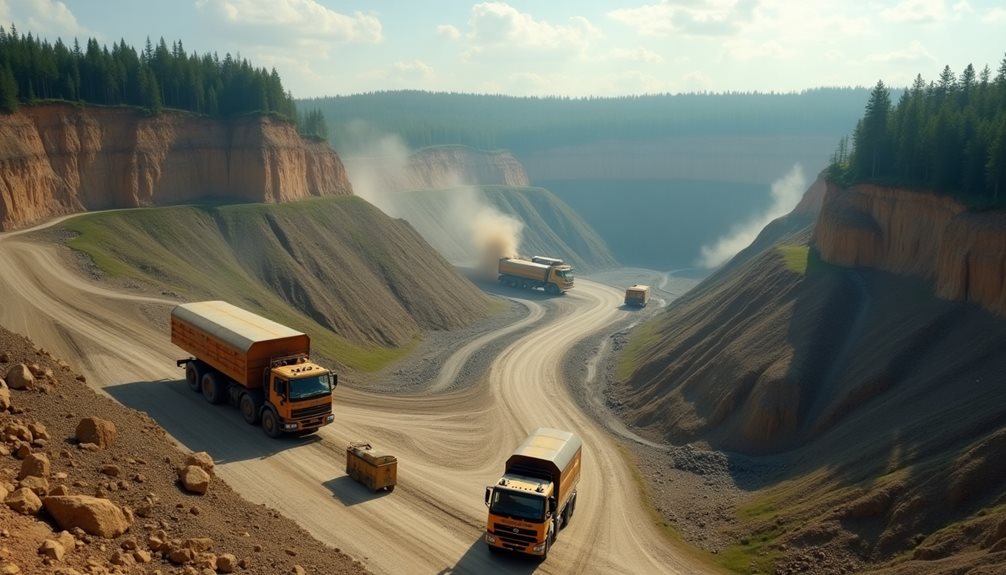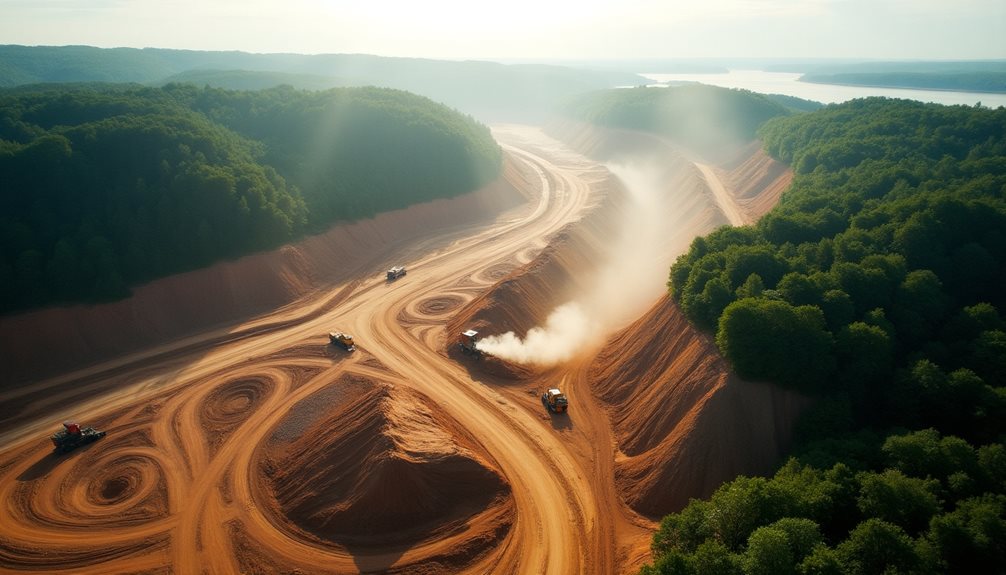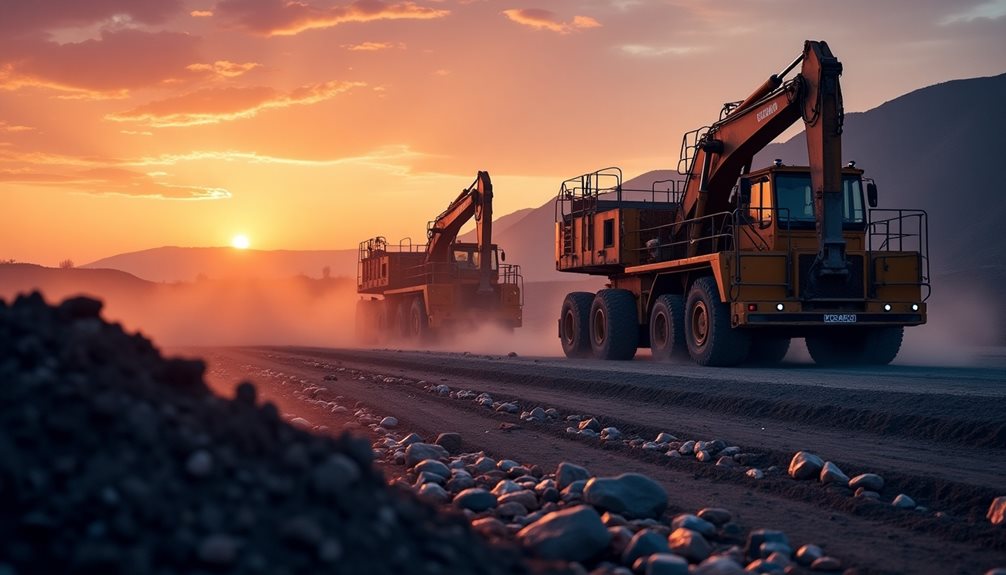Table of Contents
ToggleOverview of the Mining Industry in Russia

The mining industry in Russia represents a critical sector of the national economy, characterized by extensive natural resource deposits and advanced extraction technologies.
With a mining history that dates back centuries, Russia has evolved into one of the world’s leading producers of minerals, including coal, iron ore, gold, and diamonds. The country’s mineral wealth is immense, with natural resources estimated at approximately $75 trillion, positioning Russia as a global powerhouse in mining. Russia consistently ranks among the top three producers of key commodities such as platinum, gold, and iron ore, and holds leading positions in the production of a wide range of minerals—including nickel, palladium, copper, and vanadium—further highlighting the sector’s diversity and strength.
The sector considerably contributes to the country’s GDP and employment, underpinning regional economies and infrastructure development. For example, oil revenues alone account for about 14% of Russia’s GDP, while the metallurgical sector contributes nearly 19% of industrial production value and employs over a million people. Investments in mineral extraction and metallurgy represent about 20% of the nation’s total investment, demonstrating the industry’s foundational role in Russia’s economic stability and growth.
In addition, the economic impact of mining extends beyond immediate financial gains, influencing trade balances and foreign investments. The export of minerals such as iron, steel, and precious metals generates significant revenue, supporting Russia’s positive trade balance and attracting further investment into the sector. The development of world-class mining facilities, such as the Olimpiada gold mine and the Aikhal diamond complex, underscores Russia’s commitment to leveraging its natural advantages for sustained economic benefit.
As global demand for raw materials continues to rise, the industry faces challenges such as regulatory changes and environmental concerns, necessitating a balance between resource extraction and sustainable practices to guarantee long-term viability and freedom in economic pursuits. Russian mining companies are increasingly adopting modern technologies and environmental standards to address these concerns, ensuring that operations remain efficient and responsible. At the same time, the sector’s resilience is evident in its ability to adapt to global market fluctuations and external pressures, maintaining competitiveness and supporting domestic industry even in challenging times.
Overall, Russia’s mining industry stands as a pillar of national prosperity, driving technological advancement, regional development, and international trade, while continuously evolving to meet the demands of a dynamic global market.
| Statistic | Value | Details/Notes |
|---|---|---|
| Estimated value of Russia’s natural resources | $75 trillion | Includes minerals, oil, gas, etc. |
| Russia’s ranking in global mineral production | Top 3 | For key commodities like platinum, gold, and iron ore |
| Contribution of oil revenues to Russia’s GDP | 14% | Significant part of the national economy |
| Metallurgical sector’s share of industrial production value | 19% | Major segment of industrial output |
| Employment in the metallurgical sector | Over 1 million people | Direct employment |
| Share of investment in mineral extraction and metallurgy | 20% of total investment | Large portion of national investment |
| Number of world-class mining facilities mentioned | 2 | Olimpiada gold mine, Aikhal diamond complex |
All figures are based on the provided text and reflect the importance and scale of the mining industry in Russia.
Key Mining Terms in Russian
Understanding key mining terms in Russian is essential for professionals, students, and anyone involved in the industry. Mastery of this specialized vocabulary ensures clear communication of technical details, operational procedures, and safety protocols.
Fundamental terms like “добыча” (extraction), “разработка” (development), and “шахта” (mine) are central to discussions about mining projects. Equally important are words such as “платформа” (platform) and “геология” (geology), which are crucial for site assessments and resource evaluations.
A solid grasp of these expressions not only improves collaboration but also supports compliance with safety and regulatory standards, making it invaluable for navigating the complexities of the Russian mining sector.
Below, you will find explanations of key Russian mining terms, practical examples, and a concise reference table to aid your learning and application.
Mining Terms
Mining operations involve many technical processes. Here are some crucial Russian words and their uses:
- Добыча (doh-BY-cha) — extraction
This term is used when talking about removing minerals or resources from the ground. For example: “добыча нефти” means “oil extraction.” - Разработка (rahz-rah-BOHT-ka) — development
This word refers to the process of preparing a site for mining. For example: “разработка месторождения” means “deposit development.” - Шахта (SHAHKH-ta) — mine
This is the general term for a mine, usually an underground tunnel or site where resources are extracted. - Платформа (plaht-FOR-ma) — platform
This can refer to a platform structure used during extraction or exploration. - Геология (gee-oh-LOH-gee-ya) — geology
The study of the earth and its structure, which is important in finding and evaluating mineral resources.
Related Russian Mining Terms
Below is a table of related terms that are often used in mining conversations. These will help expand your vocabulary and make it easier to follow technical discussions.
| Russian (Cyrillic) | English Phonetic | English Definition |
|---|---|---|
| рудник | ROOD-neek | ore mine |
| карьер | kar-YER | open-pit mine, quarry |
| уголь | OO-gol’ | coal |
| руда | roo-DAH | ore |
| полезные ископаемые | pah-LEZ-ni-ye ee-skah-PAH-ye-mi-ye | mineral resources |
| бурение | boo-REH-nye | drilling |
| вентиляция | ven-tee-LYAT-see-ya | ventilation |
| взрывчатка | vzryv-CHAT-ka | explosives |
| оборудование | oh-boh-ROOD-uh-vah-nye | equipment |
| безопасность | beh-zoh-pahs-NOST’ | safety |
| рабочий | rah-BOH-chee | worker |
| надзор | nahd-ZOR | supervision/regulation |
| транспортировка | trans-port-ee-ROHV-ka | transportation |
| запас | zah-PAS | reserve |
Using These Terms
Learning these terms will help you read documents, communicate with Russian-speaking colleagues, and understand industry news. For example, if you see a phrase like “бурение скважин для добычи угля,” you can break it down:
- бурение (drilling)
- скважин (wells)
- для (for)
- добычи (extraction)
- угля (coal)
So, it means “drilling wells for coal extraction.”
Expanding your vocabulary with these key mining terms will make your understanding of Russian mining topics much easier and more effective.
Natural Resources and Their Significance
Natural resources are the cornerstone of Russia’s mining industry, fueling economic growth and technological progress. Russia’s vast mineral reserves—spanning coal, metals, precious stones, and rare earth elements—position the country as a global leader in supplying the raw materials essential for modern infrastructure, manufacturing, and energy production.
Beyond their role in extraction, these resources are vital for advancing sustainability and supporting the transition to green technologies. Minerals like copper, nickel, and rare earth elements are indispensable for renewable energy systems, electric vehicles, and innovative industrial applications. The mining sector’s contribution extends to the development of roads, railways, and urban centers, reinforcing Russia’s economic resilience and international influence.
Effective stewardship of natural resources ensures not only ongoing economic benefits but also responsible management for future generations. By embracing sustainable mining practices and technological innovation, Russia’s mining industry continues to strengthen its position as a reliable supplier of critical materials while supporting national prosperity and global progress.
Key Aspects in the Mining Sector
(Ключевые аспекты горнодобывающего сектора)
Russia’s mining sector is vital for the country, influencing both its economy and society. For English speakers learning Russian, understanding this topic will also help you grasp important vocabulary and cultural context.
Economic Growth
(Экономический рост — Ekonomicheskiy rost)
1. Job Creation (Создание рабочих мест — Sozdaniye rabochikh mest)
Mining is one of the largest employers in Russia. Millions are involved in extracting resources, processing them, or providing services to mining companies. These jobs range from miners (шахтёр — shakhter) and engineers (инженер — inzhener) to geologists (геолог — geolog) and transport workers (транспортник — transportnik).
Example:
A new gold mine in Siberia can create thousands of jobs for local residents.
2. Regional Development (Развитие регионов — Razvitiye regionov)
Mining often takes place in remote regions (отдалённые регионы — otdalyonnyye regiony) such as Siberia (Сибирь — Sibir), the Far East (Дальний Восток — Dal’niy Vostok), and the Urals (Урал — Ural). The industry brings infrastructure (инфраструктура — infrastruktura): roads, electricity, schools, and hospitals.
Example:
A mining company might build a new road (дорога — doroga) to reach a mine, which also benefits nearby villages.
3. Exports (Экспорт — Eksport)
Russia is a leading exporter of natural resources:
- Oil (нефть — neft’)
- Natural gas (природный газ — prirodnyy gaz)
- Coal (уголь — ugol’)
- Gold (золото — zoloto)
- Diamonds (алмазы — almazï)
- Metals (металлы — metally)
Export revenues (доходы от экспорта — dokhody ot eksporta) are used for national projects and social programs.
4. Industrial Base (Промышленная база — Promyshlennaya baza)
The mining sector supplies raw materials for factories (заводы — zavody), construction companies (строительные компании — stroitel’nye kompanii), and technology firms (технологические фирмы — tekhnologicheskiye firmy).
Example:
Steel from the Urals is used to build bridges and skyscrapers across Russia.
Related Russian Terms
| Russian Term | Phonetic | English Definition |
|---|---|---|
| горнодобывающий сектор | gornodobïvayushchiy sektor | mining sector |
| шахта | shákhta | mine |
| шахтёр | shakhter | miner |
| нефть | neft’ | oil |
| уголь | ugol’ | coal |
| золото | zoloto | gold |
| алмазы | almazï | diamonds |
| металлы | metally | metals |
| инфраструктура | infrastruktura | infrastructure |
| рабочие места | rabochiye mesta | jobs, workplaces |
| регион | region | region |
| экспорт | eksport | export |
| доходы | dokhody | income, revenues |
| промышленность | promyshlennost’ | industry |
| завод | zavod | factory |
| развитие | razvitiye | development |
This set will help you read, listen, and discuss key points about Russia’s mining sector in Russian.
Equipment and Technologies in Mining
The Russian mining industry stands at the forefront of technological innovation, leveraging advanced equipment and digital solutions to drive efficiency, productivity, and safety across its vast mineral resource base.
Modernization of Equipment
Russian mining operations utilize a comprehensive array of machinery, including excavators, drills, loaders, crushers, and conveyors. These machines are essential for the exploration, extraction, transportation, and processing of minerals such as coal, iron ore, platinum, gold, and diamonds. The adoption of modern mining equipment is particularly crucial given Russia’s position as a global leader in mineral production, with significant reserves and output in key commodities.
Technological Advancements and Automation
The sector has witnessed a significant shift towards automation and digitalization. Technologies such as automated drills, unmanned haul trucks, and robotics are increasingly common, enabling mines to operate more efficiently and with enhanced safety. Automation reduces operational costs and minimizes human exposure to hazardous conditions, aligning with the industry’s goal of protecting worker health and safety.
Digitalization and Mining 4.0
Russia is actively embracing the principles of Mining 4.0, which integrates digital modeling, real-time data analytics, and remote monitoring systems into mining operations. These technologies allow for ultra-fast, reliable operational control and predictive maintenance, reducing equipment downtime and optimizing resource extraction. The use of artificial intelligence and machine learning further empowers mining professionals to make informed decisions, streamline processes, and implement sustainable resource management practices.
Import Substitution and Domestic Innovation
While Russia has historically relied on imported mining equipment—sometimes accounting for over 50% of machinery in certain segments—the industry is increasingly focused on developing domestic manufacturing capabilities. This shift has been accelerated by recent global supply chain challenges and a national emphasis on technological sovereignty. As a result, Russian manufacturers are investing in research and development to produce high-tech, energy-efficient, and environmentally responsible mining solutions.
Sustainable and Safe Mining Practices
Modern equipment is designed with sustainability in mind, featuring energy-efficient systems, advanced waste management solutions, and technologies that minimize environmental impact. Enhanced safety features, such as remote-controlled and unmanned equipment, further reduce risks for workers and contribute to a safer mining environment.
Competitive and Future-Oriented Market
The Russian mining equipment market is highly competitive, with both domestic and international players striving for innovation and market share. Strategic partnerships, product innovation, and expansion of distribution networks are common strategies. Looking ahead, the industry is poised for continued growth, driven by ongoing infrastructure development, increasing demand for minerals, and the rapid adoption of advanced technologies.
Russia’s mining industry is not only a pillar of national economic strength but also a showcase for technological progress. Through the integration of state-of-the-art equipment and digital solutions, Russian mining is setting new standards in efficiency, safety, and sustainability—ensuring its continued leadership in the global mining arena.
Mining Processes and Techniques
Efficient resource extraction employs a variety of processes and techniques tailored to the specific geological and material characteristics of a mining site. Understanding these processes is essential for optimizing production while adhering to sustainable practices.
Key extraction methods include:
1. Open-pit Mining: This process involves digging a large pit in the ground to remove minerals near the surface.
Russian: Открытая разработка (ot-KRY-ta-ya raz-ra-BOT-ka)
Example: Gold, copper, and iron ore are often extracted using open-pit mining.
2. Underground Mining: Used to reach minerals deep below the earth’s surface. Miners dig shafts (vertical passages) and tunnels (horizontal passages).
Russian: Подземная добыча (pod-ZEM-na-ya do-BY-cha)
Example: Coal, diamonds, and some metals are commonly mined this way.
3. In-situ Leaching: Chemicals are pumped underground to dissolve minerals, which are then brought to the surface in liquid form. This method causes less surface damage.
Russian: Вскрышное выщелачивание (vsk-RYSH-no-ye vy-sche-LA-chi-va-ni-ye)
Example: Often used for uranium and some copper deposits.
Related Russian Terms for Mining Techniques
| Russian (Cyrillic) | English Phonetic | English Definition |
|---|---|---|
| шахта | SHAH-ta | Mine (underground) |
| рудник | ROOD-neek | Ore mine |
| порода | pa-RO-da | Rock |
| полезные ископаемые | pa-LEZ-ny-ye is-ka-PA-e-my-e | Mineral resources |
| добыча | da-BY-cha | Extraction |
| карьер | kar-YER | Quarry / Open-pit |
| подземный | pod-ZEM-ny | Underground |
| поверхность | pa-VERKH-nost’ | Surface |
| раствор | ras-TVOR | Solution (liquid mixture) |
| окружающая среда | ok-ru-ZHA-yu-shcha-ya sreda | Environment |
| устойчивое развитие | us-TOY-chih-va-ye raz-VI-ti-ye | Sustainable development |
| бурение | boo-RE-ni-ye | Drilling |
| тоннель | ton-NEL’ | Tunnel |
| валун | va-LOON | Boulder / Large rock |
| выемка | VY-em-ka | Excavation |
These terms will help you discuss mining in Russian and understand more about resource extraction, technology, and environmental concerns in Russian-speaking contexts.
Environmental Considerations in Mining

The extraction of mineral resources invariably impacts the surrounding environment, necessitating an all-encompassing approach to environmental considerations in mining operations.
Sustainable practices are essential to mitigate the ecological impact associated with mining activities. This involves implementing strategies such as reforestation, soil stabilization, and water management to minimize degradation of natural habitats.
Additionally, mining companies are increasingly adopting technologies that reduce emissions and enhance resource efficiency. Evaluating the cumulative ecological impact prior to project initiation allows for informed decision-making and the identification of potential risks.
Continuous monitoring and adaptive management practices are vital for ensuring compliance with environmental regulations and promoting ecological restoration.
Ultimately, prioritizing environmental considerations fosters responsible mining that aligns with societal values and ecological integrity.
When talking about environmental considerations in mining, it’s helpful to know key Russian words and phrases.
Sustainable Practices in Mining
Устойчивые методы в горнодобыче
To reduce environmental harm, mining companies use various sustainable practices. For example:
- Reforestation (лесовосстановление): Planting trees after mining to restore damaged ecosystems.
- Soil stabilization (закрепление почвы): Preventing soil erosion through physical and biological methods.
- Water management (управление водными ресурсами): Treating and recycling water to prevent pollution of rivers and lakes.
Technological Advances
Технологические достижения
Modern mining companies are investing in technologies that help:
- Lower air and water emissions (снижение выбросов в атмосферу и воду)
- Improve energy efficiency (повышение энергоэффективности)
- Recycle waste materials (переработка отходов)
For example, dust control systems and water purification plants are now common at many mining sites.
Environmental Impact Assessment
Оценка воздействия на окружающую среду
Before starting a mining project, companies must evaluate how their work will affect the environment. This process is called “environmental impact assessment” (оценка воздействия на окружающую среду). It helps predict risks and plan mitigation measures.
Monitoring and Restoration
Мониторинг и восстановление
Continuous monitoring ensures that mining activities comply with environmental laws and standards. Restoration projects, such as planting native vegetation or creating wildlife corridors, help return the land to its natural state after mining ends.
Related Russian Terms for Mining and Environment
| Русский термин | English Phonetic | English Definition |
|---|---|---|
| окружающая среда | okruzháyushchaya sredá | environment |
| горнодобыча | gornodobýcha | mining |
| устойчивое развитие | ustóychivoye razvítie | sustainable development |
| лесовосстановление | lesovosstanovlénie | reforestation |
| водные ресурсы | vódnye resúrsy | water resources |
| загрязнение | zagryaznénie | pollution |
| выбросы | výbrosy | emissions |
| переработка отходов | pererabótka otkhódov | waste recycling |
| почва | póchva | soil |
| мониторинг | monitoríng | monitoring |
| восстановление | vosstanovlénie | restoration |
| оценка воздействия | otsénka vozdeystvíya | impact assessment |
| экосистема | ekosístema | ecosystem |
Using these terms, learners can discuss environmental issues in mining both in English and Russian.
Safety Regulations and Practices
A thorough and well-structured framework of safety regulations and practices is absolutely essential for minimizing the numerous risks and hazards associated with complex mining operations. The effective implementation and strict enforcement of these comprehensive safety measures guarantee the protection and well-being of all personnel involved, as well as the preservation and safeguarding of the surrounding environment.
Key components include:
- Safety Training: Безопасность (Bezopasnost’). Extensive, ongoing training programs designed to educate and inform workers about hazard recognition, safe work procedures, and emergency response protocols. These programs ensure that employees are fully prepared to handle any potential dangers that may arise during their daily tasks.
- Regulatory Compliance: Соответствие (Sootvetstvie). Strict adherence to both local and international standards and regulations governing health, safety, and environmental protection. This compliance guarantees that mining operations meet or exceed all legal requirements, reducing liability and promoting responsible management practices.
- Regular Inspections: Регулярные проверки (Regulyarnye proverki). Routine and systematic assessments of equipment, machinery, and work environments to identify potential hazards early on. These inspections enable timely maintenance, repairs, and risk mitigation strategies that prevent accidents and ensure operational safety.
![]()
Together, these critical elements collectively foster a robust culture of safety within mining organizations. They empower workers to perform their duties confidently while prioritizing their own well-being and that of their colleagues, ultimately contributing to safer, more efficient, and environmentally responsible mining operations.
The Future of Mining in Russia
With a strong emphasis on safety regulations and practices, the mining industry in Russia is poised for significant evolution in the coming years.
The integration of sustainable practices will be essential in aligning with global environmental standards, promoting responsible resource extraction. Technological innovations, such as automation and advanced data analytics, are expected to enhance operational efficiency and reduce environmental impact.
Adoption of renewable energy sources within mining operations will further support sustainability goals. Furthermore, the collaboration between government entities and private sectors will facilitate investment in research and development, leading to breakthroughs in mineral processing and waste management.
As these advancements unfold, the future of mining in Russia appears to be a blend of economic growth and ecological stewardship, reflecting a commitment to progress and responsibility.
Frequently Asked Questions
What Are the Major Minerals Mined in Russia?
The major minerals mined in Russia include gold extraction, coal, iron ore, and nickel. These mineral resources greatly contribute to the country’s economy, reflecting its vast geological diversity and strategic importance in the global market.
How Is Mining Regulated in Different Russian Regions?
Mining regulation varies across Russian regions, with distinct regional regulations governing operations. Compliance measures are implemented to guarantee adherence to environmental standards and safety protocols, reflecting the diverse administrative approaches and resource management strategies employed nationwide.
What Language Skills Are Needed for Mining Jobs in Russia?
In mining jobs in Russia, language proficiency in Russian is essential. Workers must grasp technical terminology related to operations and safety protocols, ensuring effective communication and adherence to regional regulations within diverse mining environments.
What Are the Career Opportunities in the Russian Mining Sector?
The Russian mining sector offers diverse career paths, including engineering, geology, and environmental management. Job prospects remain robust due to ongoing demand for minerals, providing opportunities for skilled professionals seeking advancement in a dynamic industry.
How Does the Mining Industry Impact Local Communities in Russia?
The mining industry markedly influences local communities in Russia through community development initiatives and economic opportunities, while simultaneously raising concerns regarding environmental impact, including habitat degradation and pollution, necessitating a balance between growth and sustainability.



